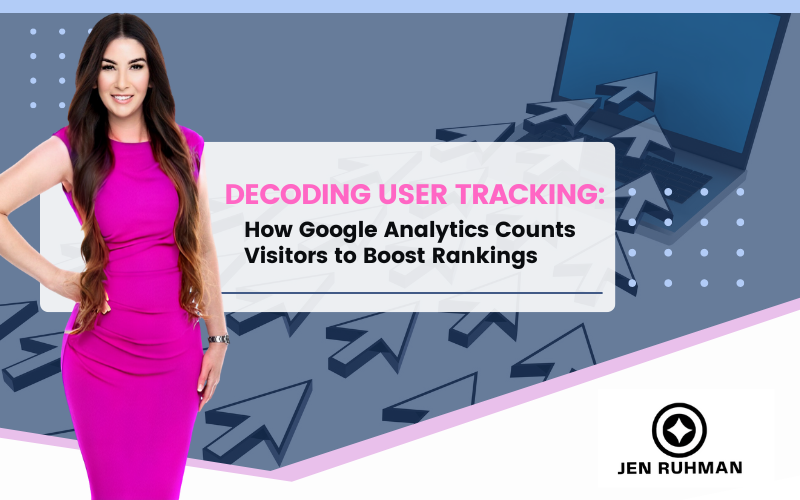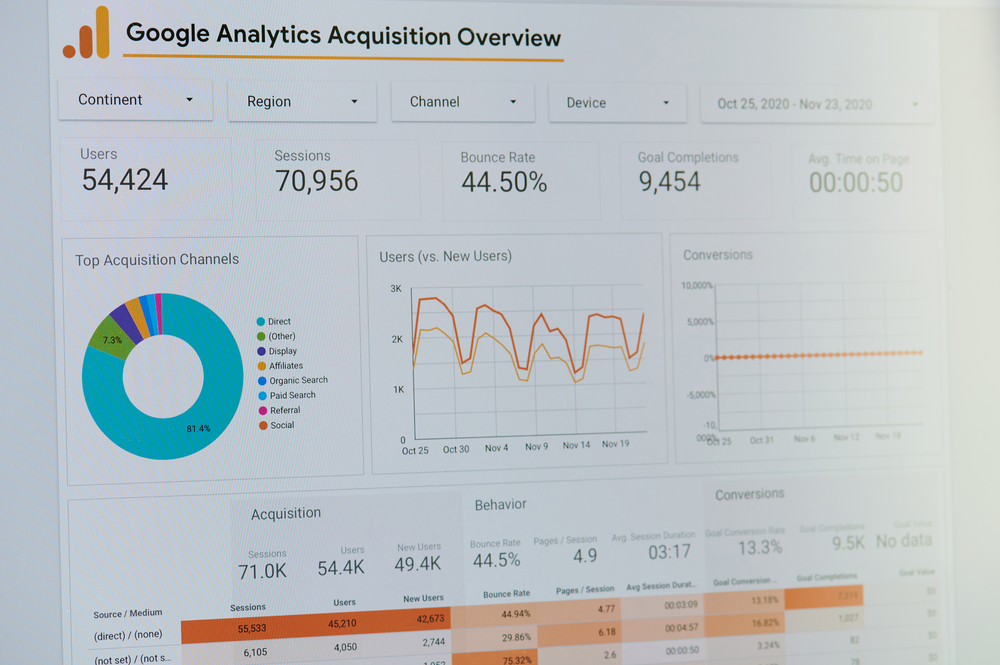
Aug 12, 2024 | SEO Tips

SEO Strategies for Building Trust and Ranking Higher: A San Diego SEO’s Perspective
Hey there! I’m Jen Ruhman, owner of Jen Ruhman SEO, a digital marketing agency here in sunny San Diego. We help businesses of all shapes and sizes climb the Google rankings and get noticed online.
Today, I want to talk about building trust with Google and ranking higher in search results. It’s a bit like building a strong friendship – it takes time, effort, and a genuine connection. Now, some industries have a tougher time making those friends (read: Google) than others. Let’s dive into why and what you can do about it!
Industries That Need More Time to Earn Google’s Trust
Here’s the thing: Google prioritizes websites that users can trust. They want to show searchers the most reliable and helpful information available. This means certain industries naturally face more hurdles when it comes to ranking high. Here are a few examples:
1. Financial Services:
Picture this: You’re searching for a new investment strategy. Are you going to trust a random website or a well-established bank? Exactly! The financial services industry is full of big names and strict regulations. This means it takes extra effort for newer players to stand out.
My Tip: Focus on creating high-quality content like educational blog posts and in-depth guides. Show your expertise! Building trust with potential clients also means prioritizing security. Make sure your website is encrypted and uses secure payment gateways. Think of it as putting a padlock on your online office!
2. Healthcare:
When it comes to your health, you want the best information, right? That’s why Google holds healthcare websites to a high standard. Medical topics are complex, so your content needs to be accurate and come from a trusted source (like a doctor!).
My Tip: Partner with qualified healthcare professionals to create your content. This shows Google you’re serious about providing reliable information. Also, patient privacy is paramount. Make sure your website is HIPAA compliant and clearly explains how you handle user data.
3. Legal Services:
The legal field is crowded, with countless lawyers vying for attention. Building a strong reputation takes time, and Google knows that.
My Tip: Local SEO is key for lawyers! Focus on optimizing your website for your specific area. Think about the search terms potential clients might use to find you. Testimonials and positive reviews from satisfied clients also go a long way in building trust with Google and potential customers.
4. E-commerce (High-Ticket Items):
Imagine spending thousands of dollars online on a new watch or piece of furniture. You’d want to be super confident about the seller, right? That’s why Google prioritizes established e-commerce stores for high-value items.
My Tip: Customer reviews are your best friend! Encourage satisfied buyers to leave positive feedback on your website and other platforms. High-quality product photos and detailed descriptions can also build trust with potential buyers.
5. Adult Industries:
Let’s be honest, the adult industry faces unique challenges online. Google has strict policies on adult content, making it difficult to rank highly in search results. Additionally, building trust with both search engines and users can be tough.
My Tip: While I can’t offer specific SEO advice for this industry due to Google’s guidelines, focusing on creating high-quality, informative content that caters to a specific niche within the adult industry could be a potential approach. It’s important to always comply with Google’s content policies.
Building Trust and Ranking Higher: It’s a Marathon, Not a Sprint
Remember, even for industries outside this list, building trust and ranking higher takes consistent effort. Here are some key factors to focus on:
- High-Quality Content: This is the golden rule of SEO. Create informative, engaging content that solves your target audience’s problems.
- Website Authority: Think of it as your online reputation. Over time, you build authority through backlinks (mentions of your website on other reputable sites) and positive reviews.
- User Experience: Make your website user-friendly! Fast loading speeds, clear navigation, and a mobile-friendly design are all crucial.
- Local SEO (if applicable): For businesses with a brick-and-mortar location, optimizing your website for local search is essential.
Need Help Climbing the Google Ladder?
Building trust and ranking higher takes time and dedication. But with the right strategies, any business can succeed in the digital world. Here at Jen Ruhman SEO, we help businesses in San Diego and beyond achieve their SEO goals.
Free SEO Consultation: Let’s Get Your Business Found!
So, you’ve read about the challenges some industries face in the world of SEO, right? Well, as a trusted SEO company in San Diego, I’m here to tell you that even though it might seem like an uphill battle, with the right strategy, your business can absolutely dominate the search results.
I offer free SEO consultations to help you understand your unique situation and develop a plan to reach your goals.
During our chat, we’ll dive into your business, your target audience, and your competition. I’ll share insights into the latest SEO trends and best practices. And most importantly, I’ll provide actionable steps you can take to improve your website’s visibility.
Think of me as your personal SEO cheerleader! I’m passionate about helping businesses succeed online, and I’m excited to see how I can help you reach new heights.
Ready to take the next step? Visit my website, https://jenruhman.com/, to schedule your free consultation today!
Remember, building a strong online presence is like building a house. It takes time, effort, and a solid foundation. But with the right tools and guidance, you can create a digital home that attracts visitors and turns them into loyal customers.
Let’s work together to make your business a search engine superstar!
Would you like to learn more about specific SEO strategies or discuss a particular challenge you’re facing?

Jul 18, 2024 | SEO Tips
Hey San Diego Businesses, It’s Jen Ruhman Here!

Are you tired of feeling invisible online? Your website has so much potential, but if it’s buried on page ten of Google, it’s not doing much for your bottom line. That’s where I come in!
I’m Jen, San Diego’s go-to gal for all things local SEO. I’ve spent over a decade helping countless businesses just like yours dominate local search and watch their customer base explode.
Imagine this: Your website is buzzing with activity. Qualified leads are filling out contact forms, your phone’s ringing off the hook, and your door is swinging open with new customers – all thanks to the power of strategic SEO. No more wasting money on temporary ad campaigns. Local SEO is an investment that keeps on giving!
Here’s how I can help your San Diego business soar:
Leave the Competition in the Dust: I’ll use my SEO expertise to skyrocket your website’s ranking for searches San Diego peeps are actually typing into Google. This means more qualified leads, calls, and foot traffic – organically, without relying on expensive ads. Forget national competition, we’re all about crushing it in San Diego!
Laser-Focused on San Diego: Forget generic SEO campaigns that miss the mark. I’ll tailor a strategy that targets San Diego-specific searches, ensuring your business appears exactly when local customers need you. Whether you’re a beachside taco shack or a high-end jeweler in La Jolla, I’ll understand the unique search terms your ideal customer uses.
Results You Can See (and Track!): Data is my best friend, and I’m all about showing you the results of my work. You’ll get crystal-clear reports on website traffic, conversions, and how my SEO strategy is directly boosting your business. No empty promises, just a proven approach that gets results. We’ll track key metrics like website ranking, bounce rate, and conversion rates so you can see the impact of SEO in real-time.
Industry Whisperer: Whether you’re slinging delicious coffee or fighting for justice, I understand the unique challenges of your industry. I’ll craft a customized SEO plan to maximize your online presence and put your business in front of the exact San Diego audience you want to reach. From dentists to dog walkers, I’ve seen it all and know how to optimize your website for local success.
Ditch the click-chasing and start owning local search!
Ready to unleash the power of SEO for your San Diego business?
- Let’s Chat! Schedule a free consultation with me by calling or texting (619) 719-1315.
- Visit JenRuhman.com: Discover how local SEO can transform your online presence and bring a wave of new customers your way!
P.S. Organic search results have lasting power, unlike those fleeting ads. Invest in SEO and watch your website become a magnet for San Diego customers for years to come. Let’s make your business the talk of the town (in the best way possible)!
But wait, there’s more! Local SEO isn’t just about ranking high on Google. It’s about building trust and authority with potential customers in San Diego. Here are some bonus tips to supercharge your local SEO efforts:
- Claim and Optimize Your Google My Business Listing: This is your free golden ticket to local search domination. Make sure your listing is accurate, complete with high-quality photos, positive reviews, and your latest business hours. Respond to all reviews, both positive and negative, to show you care about your customers.
- Get Listed in Local Directories: There are tons of online directories specifically for San Diego businesses. Get listed in relevant directories with accurate information to increase your online visibility.
- Embrace the Power of Online Reviews: Positive online reviews are gold in the local SEO world. Encourage satisfied customers to leave reviews on Google, Yelp, and other relevant platforms. Respond to positive reviews with a “thank you” and address negative reviews professionally.
- Become a Local Content King/Queen: Create high-quality, engaging content that caters to your San Diego audience. This could be anything from blog posts about local events to informative articles about your industry.
By implementing these strategies, you’ll not only improve your local SEO ranking but also build trust and credibility with potential customers.
Remember, SEO is a marathon, not a sprint. But with dedication and the right partner by your side (that’s me!), you can watch your San Diego business thrive online and attract a steady stream of new customers.
Let’s face it, running a business in San Diego is a dream. But with so much competition, it can be tough to cut through the noise and get noticed. That’s where I come in! I’m passionate about helping San Diego businesses like yours unlock their full potential online. Here are some additional ways I can be your secret weapon:
- Competitor Analysis: We don’t operate in a vacuum. I’ll delve deep into your local competitors’ online presence, uncovering their SEO strengths and weaknesses. This intel allows us to craft a strategy that surpasses them in the search engine rankings.
- Mobile-First Optimization: San Diegans are a mobile bunch. We love searching for businesses and making purchases on our smartphones. I’ll ensure your website is mobile-friendly and provides a seamless user experience for on-the-go customers.
- Embrace the Power of Social Media: Social media isn’t just for posting cat videos (although, who doesn’t love those?). It’s a powerful tool for connecting with local customers. I can help you develop a social media strategy that showcases your business personality, engages your audience, and ultimately drives traffic to your website.
- Stay Ahead of the Curve: The world of SEO is constantly evolving. Google’s algorithm updates can feel like a game of whack-a-mole. But fear not! I stay up-to-date on the latest SEO trends and best practices so your website remains optimized and visible for local searches.
Investing in local SEO is an investment in the future of your San Diego business.
When you partner with me, you’re not just getting an SEO expert, you’re getting a dedicated advocate who wants to see you succeed. Here’s what sets me apart:
- Personalized Approach: Every business is unique, and your SEO strategy should be too. I won’t offer a cookie-cutter solution. I’ll take the time to understand your specific needs and goals, then develop a customized plan to achieve them.
- Communication is Key: I believe in clear and consistent communication. You’ll always be in the loop on what I’m doing to optimize your website and the results we’re achieving.
- Measurable Results: Like I mentioned before, data is my best friend. I’ll provide you with regular reports that track your website’s progress and demonstrate the impact of our SEO efforts.
Ready to take your San Diego business to the next level?
Don’t let the competition steal the spotlight. Schedule a free consultation with me today and let’s chat about how local SEO can transform your online presence and turn you into the local hero San Diego customers are searching for!
Call or text us at (619) 719-1315 to chat about how my San Diego SEO company can transform your website into a lead-generation machine.
Remember, San Diego is a vibrant city full of opportunity. Let’s work together to make sure your business shines as brightly as the California sun!

May 21, 2024 | SEO Tips

Hi there! Jen Ruhman, your friendly neighborhood SEO expert here!
Today, I want to chat about something that’s critical for any med spa looking to thrive in the bustling San Diego market: SEO, or Search Engine Optimization.
Let’s face it, San Diego is brimming with amazing med spas offering top-notch treatments and rejuvenation services. But in such a competitive landscape, how do you make your spa stand out from the crowd and ensure potential clients searching for “Morpheus8 San Diego” or “PDO Threads San Diego” find you first? That’s where SEO comes in, and trust me, it’s a game-changer!
Demystifying SEO for Med Spas: Let’s Get Technical (but Keep it Fun!)
SEO essentially boils down to a set of strategies we use to boost your website’s visibility on search engine results pages (SERPs) – think of it like the prime real estate of the internet. The higher you rank, the more likely potential clients are to discover your amazing med spa.
So, how do we achieve this magic? Here’s the gist:
- Keyword Magic: We strategically sprinkle relevant keywords throughout your website and content, like “Morpheus8 San Diego” or “PDO Threads in San Diego.” These are the search terms people use to find the services you offer, so using them effectively is like having neon signs flashing “Come visit us!” to potential clients.
- Content that Captivates: We don’t just stuff keywords in for the sake of it – we craft high-quality, informative content that engages readers. Think detailed blog posts, FAQs that answer all those burning questions about treatments, and even client testimonials raving about their Morpheus8 experience.
- Website Structure Savvy: We ensure your website is well-organized and easy to navigate. Imagine your website as your spa – it should be inviting and user-friendly, allowing visitors to find what they need effortlessly.
- Building Trust with Backlinks: Backlinks are essentially like citations from trusted sources on the internet, vouching for your expertise. The more high-quality backlinks your website has, the more authoritative it appears to search engines, boosting your ranking.
Why You, as a San Diego Med Spa, Absolutely Need SEO
Competition is Fierce, But We Can Help You Conquer It!
San Diego’s med spa scene is thriving, and with so many options available, it’s easy for your spa to get lost in the shuffle. But fear not! By implementing a strategic SEO plan, we can ensure your spa appears at the top of search results when potential clients in the area are looking for treatments.
Location, Location, Location (and SEO!)
Local SEO is a game-changer for med spas. Most clients seeking these services look for providers close by. Optimizing your website for local searches ensures you show up for people in your neighborhood searching for “PDO Threads San Diego” – after all, convenience is key!
Embracing the Cutting Edge: How New Technologies Can Boost Your Spa’s SEO
Innovation is Key, and SEO Loves It!
The world of med spa treatments is constantly evolving, with new technologies like Morpheus8 and PDO threads taking center stage. These advancements not only enhance the services you offer but also create exciting SEO opportunities. Here’s how:
- Morpheus8 San Diego: Your New SEO Powerhouse
Morpheus8 is a revolutionary treatment combining microneedling and radiofrequency for skin rejuvenation. By incorporating keywords like “Morpheus8 San Diego” into your content strategy, you can attract clients seeking this latest advancement. We can create detailed blog posts explaining the treatment, its benefits, and why your spa is the perfect place to experience it.
- PDO Threads in San Diego: SEO for a Threadlift to Success
PDO threads are a non-surgical option for lifting and tightening the skin. Let’s target this growing trend with SEO! We can craft informative content like videos and articles explaining the procedure and its advantages. Optimizing for local search terms like “PDO Threads San Diego” ensures nearby clients looking for this treatment discover your spa.
Keyword Research: The Cornerstone of Your SEO Strategy
Finding the Golden Search Terms
Keyword research is the foundation of any successful SEO campaign. It’s all about identifying the specific search terms potential clients use to find med spa services. Think of it like deciphering a secret language – once we crack the code, we can tailor your website and content to speak directly to those seeking your services.
Optimizing Your Website for Success: On-Page SEO for Med Spas
Now that we’ve unlocked the power of keywords, let’s optimize your website to truly shine on search engines. This is where on-page SEO comes in – it’s all about making your website content informative, engaging, and, of course, keyword-rich.
Content is King (and Queen!):
- Informative and Engaging: Craft website content that educates potential clients about your services, from detailed treatment descriptions to blog posts addressing common concerns. Think of it as your online brochure, but way more interesting!
- Keyword Magic, Revisited: Integrate relevant keywords naturally throughout your content. Don’t force it – aim for a smooth, informative flow that showcases your expertise while incorporating those search terms that will attract potential clients.
Meta Descriptions and Tags: The Unsung Heroes of SEO
These might sound technical, but meta descriptions and tags are crucial for SEO success. They’re essentially short summaries that appear on search engine results pages, giving users a quick glimpse of what your website offers.
Here’s why they matter:
- Think of Them as Headlines: Compelling meta descriptions entice users to click on your website, just like a catchy headline draws readers to a newspaper article.
- Keywords Matter Here Too: Include relevant keywords in your meta descriptions and tags to further improve your search engine ranking.
Building Authority Beyond Your Website: Off-Page SEO Strategies
On-page SEO is fantastic, but it’s not the whole picture. Off-page SEO focuses on building your website’s authority and credibility in the online world.
Here are some key strategies:
The Power of Backlinks: Remember those backlinks we mentioned earlier? They’re like votes of confidence from other websites, telling search engines yours is a trustworthy source of information. The more high-quality backlinks you have, the higher your ranking will climb.
Social Media Savvy: A strong social media presence not only connects you with potential clients but also drives traffic to your website. Regularly share engaging content on platforms like Facebook and Instagram, and encourage interaction. This can significantly boost your SEO efforts.
Content Marketing: The Gift that Keeps on Giving
Creating high-quality content that addresses common questions and concerns about med spa treatments is a powerful SEO strategy. Here are some content marketing avenues to explore:
- Blogging for Success: A blog is a fantastic platform to showcase your expertise, share informative articles about med spa treatments, and establish yourself as a thought leader in the industry.
- The Power of Video: Videos are a captivating way to explain procedures, showcase before-and-after results, and connect with potential clients on a more personal level.
Local SEO: Mastering Your Neighborhood Search Landscape
Since most med spa clients seek services close by, local SEO is essential for your San Diego spa. Let’s leverage these strategies:
- Google My Business Optimization: Claim and optimize your Google My Business profile. Ensure your information is accurate, include high-quality photos of your spa, and encourage satisfied clients to leave positive reviews.
- Local Citations and Reviews: Get your spa listed in relevant online directories and local business listings. Positive reviews on these platforms not only build trust but also enhance your local SEO ranking.
Mobile Optimization: Catering to the On-the-Go Client
With more and more people using mobile devices to search for services, having a mobile-friendly website is no longer optional – it’s essential!
Here’s what mobile optimization entails:
- Fast Loading Speeds: Nobody enjoys waiting for a website to load, especially on a mobile device. Ensure your website loads quickly and efficiently.
- Seamless Navigation: Your website should be easy to navigate on a mobile screen. Large buttons, clear menus, and a user-friendly layout are key.
- A Great User Experience: Mobile optimization is about creating a positive experience for visitors on their smartphones or tablets. This means ensuring your website is visually appealing, easy to interact with, and provides all the information a potential client needs.
Ready to unlock the potential of your online presence and turn website visitors into loyal customers?
Schedule a free consultation today! Call or text us at (619) 719-1315 to chat about how my San Diego SEO company can transform your website into a lead-generation machine.
Let’s work together to turn your hidden gem of a med spa into a thriving destination for clients seeking the latest advancements in aesthetics!

Apr 13, 2024 | SEO Tips
In today’s digital world, getting your online store seen by the right customers is key to success. That’s where SEO comes in! SEO stands for Search Engine Optimization, and it’s all about making your website friendly for search engines like Google. This way, when people search for products you sell, your store is more likely to show up near the top of the search results.

Why SEO is crucial for online stores:
Imagine you have a store filled with unique, top-quality products. You’ve poured your heart into creating the perfect selection, and you know your items would be a perfect fit for many people. But there’s one big problem: your store is tucked away in a dark alley, with no signage and barely a flicker of light.
- Without SEO, your store is this hidden gem. People walking down the main street, browsing online marketplaces, or searching for specific items will never stumble upon it. They simply won’t know your store exists, no matter how amazing your products are.
SEO is like putting up bright lights and a big, attractive sign:
- SEO makes your online store visible. By optimizing your website for search engines, you’re essentially placing a giant, glowing sign that says “Hey, I have exactly what you’re looking for!” right where potential customers can see it.
- SEO attracts the right kind of customers. When people search for specific products or browse by category, SEO helps your store appear in the results. This means you’re attracting customers who are already interested in what you sell, not just random passersby. It’s like having a targeted ad campaign that reaches people actively looking for products like yours.
The best part? SEO is like having a permanent, free billboard on the busiest street in town. Unlike traditional advertising that costs money and might not reach the right audience, SEO is an ongoing investment that can bring qualified customers to your online store for free. By implementing effective SEO strategies, you’re opening the door to a whole new world of potential customers who are actively searching for the products you offer.

How to win at E-commerce SEO
Here are some winning strategies to boost your online store’s SEO:
- Product Page Powerhouse: Make sure each product page is bursting with information and optimized for search engines. This means including clear descriptions, high-quality photos, and relevant keywords.
- Structured Data: The Secret Weapon: Structured data is like a cheat sheet for search engines, helping them understand your products better. This can lead to richer search results that grab attention.
- Happy Shoppers, Happy Search Engines: People love websites that are easy to navigate, load quickly, and offer valuable content. By focusing on user experience, you’re automatically improving your SEO.
- Mobile First: These days, most people shop online from their phones. So, make sure your website looks great and functions smoothly on all devices, especially mobiles.
- Speed Up Your Store: Nobody likes a slow website! Search engines don’t either. Optimizing your website for speed keeps visitors happy and helps your SEO.
- Content is King (and Queen): Don’t just rely on product descriptions. Create engaging content like blog posts and how-to guides to connect with your audience and boost SEO.
- Building Bridges with Links: Getting high-quality websites to link back to yours shows search engines that your store is trustworthy and important.
- Social Media Buzz: Social media is a great way to drive traffic back to your website and indirectly improve your SEO.
- Stay Ahead of the Curve: SEO best practices change over time. Regularly checking your SEO health with audits helps ensure your strategies are still effective.
Avoid these SEO blunders!
Just like with any competition, there are a few things to avoid in SEO. Don’t worry, we’ll guide you clear of common mistakes to keep your SEO efforts on track.
Don’t trip over these common SEO mistakes!
Just like any competition, SEO has its own set of pitfalls. But fear not! Here are some common mistakes to steer clear of and keep your SEO efforts running smoothly:
- Keyword Stuffing: Imagine cramming every keyword you can think of into your product descriptions until they sound nonsensical. This is keyword stuffing, and it’s a surefire way to turn off both search engines and potential customers. Focus on using relevant keywords naturally throughout your content.
- Ignoring Mobile Users: In today’s mobile-first world, forgetting about mobile users is a big blunder. If your website looks clunky or doesn’t function well on smartphones and tablets, you’re losing out on a huge chunk of potential customers. Make sure your online store offers a seamless experience on all devices.
- Neglecting Content: Your website shouldn’t be just a catalog of products. Creating high-quality, informative content like blog posts, buying guides, and FAQs keeps visitors engaged, establishes you as an authority in your field, and improves your SEO ranking.
- Broken Links: Imagine having a flashy sign that leads to a dead end. Broken links on your website do the same thing for search engines and visitors. Regularly check your website for broken links and fix them promptly.
- Duplicate Content: Having the same content appear on multiple pages of your website or across different websites confuses search engines and hurts your SEO. Create unique, valuable content for each page.
By avoiding these stumbles and focusing on the winning strategies above, you can ensure your SEO efforts lead your online store to success.
The Final Word
By implementing these SEO strategies, you can transform your online store into a magnet for customers. Remember, SEO is an ongoing process, but with dedication, you can watch your website climb the search engine ranks and your sales soar.
Want to Learn More?
If you have questions about specific SEO practices, like how often to do audits or how to optimize images, feel free to explore further resources.

Struggling to get targeted traffic to your online store?
Imagine a store packed with amazing products, but nobody knows it exists. That’s where SEO comes in. I specialize in e-commerce SEO, helping online stores like yours get seen by the right customers – those actively searching for what you sell.
Stop waiting for customers to find you. Get them coming to you.
As a proven San Diego SEO company, we’ll use powerful strategies to skyrocket your online store’s search engine ranking. Put your products directly in front of ready-to-buy customers actively searching for what you sell. Stop waiting for them to find you – let’s get them coming to you!
Ready to unlock the power of SEO for your e-commerce business?
Schedule a free consultation today! We’ll discuss how SEO can transform your website into a customer magnet, boosting your sales and growing your online store.
(619) 719-1315

Apr 8, 2024 | SEO Tips

Hi there! Jen Ruhman here, your friendly neighborhood SEO and PR expert in San Diego. In today’s noisy world, where everyone’s vying for attention, the press release remains a powerful tool in our communication toolbox.
But let’s face it, press releases can sometimes feel a bit… dry. Like they’re just for announcing new products or company milestones. Well, I’m here to tell you they can be so much more!
Think of a press release as a chance to tell your story, a story that resonates with your audience and builds a strong connection with your brand. It’s a way to share your expertise, your passion, and why you do what you do.
Here’s an example of a press release I made for a client in San Diego:

The Power of Storytelling: How Press Releases Can Help Your San Diego Business Thrive
Why Press Releases Are Your Secret Weapon
Let’s talk benefits! First off, press releases can help you get noticed.
By crafting newsworthy content, you can attract media attention and boost your brand’s visibility. But that’s just the tip of the iceberg.
A well-written press release also positions you as a trusted source of information. People start to see you as an expert, someone they can rely on. That trust is invaluable!
But the magic doesn’t stop there. Here are some hidden gems you might not know about:
- SEO Boost: Distributing your press release online can actually improve your search engine ranking! By including relevant keywords and linking back to your website, you’re making it easier for people to find you online.
- Networking Magic: Press releases can open doors to exciting partnerships and collaborations. When you reach industry influencers and potential partners, you’re expanding your network and creating new opportunities.
- Brand Champion: Regular press releases help you maintain a consistent brand voice and message. This reinforces your company’s identity and values, making a lasting impression on your audience.
- Beyond the Basics: Unexpected Benefits
Press releases can be lifesavers in unexpected situations too!
- Crisis Control: Facing a tough situation? A well-crafted press release can help you manage the narrative, share your perspective, and clear up any misunderstandings.
- Market Research Made Easy: The response to your press release can be a goldmine of information! It can tell you how people perceive your brand, what resonates with them, and where you might need to improve.
- Employee Pride and Recruitment: Sharing your company’s achievements through press releases can boost employee morale and attract top talent. It shows potential hires the exciting things you’re doing and the great culture you’ve built.
Crafting a Press Release That Shines
Now, let’s talk about making your press release stand out! Here are some tips:
- Captivating Headline: Grab attention with a clear and concise headline that piques your reader’s interest.
- Storytelling Power: Weave a narrative that connects with your audience on an emotional level. Don’t just tell them what you do – show them why it matters!
- Engaging Content: Use active voice, focus on the benefits for your audience, and ditch the jargon. Keep it clear and easy to understand!
SEO Power Up
Let’s not forget the SEO magic! Here’s how to optimize your press release for search engines:
- Keyword Magic: Sprinkle in relevant keywords to help people find your press release when they’re searching online.
- Backlink Boost: Include links back to your website to drive traffic and improve your domain authority (a fancy SEO term for how trustworthy your site is seen as).
- Finding the Right Audience: Choose the right distribution channels to ensure your press release reaches the people who matter most.
Learning From the Best
By analyzing successful press releases, you can gain valuable insights into how they achieve their goals. Look at the structure, the strategy, and the kind of results they delivered.
Adding expert opinions to your press release can also boost its credibility, offering valuable perspectives that enrich the content.
Common Pitfalls to Avoid
Remember, a press release isn’t about bragging. It’s about connecting with your audience. Avoid being overly promotional, neglecting their needs, or failing to deliver a clear message.
Measuring Your Success
So, you’ve crafted a stellar press release – how do you know it’s working? Track metrics like media coverage, website traffic, and engagement levels. This information will help you refine your strategy for even better results in the future.
The Future of Press Releases
The world of communication is constantly evolving, and press releases are evolving with it. By staying tuned to trends like the rise of digital media and the importance of storytelling, you can leverage press releases to their full potential.
So, there you have it.
Ready to Unleash the Power of Press Releases?
If you’re a San Diego business owner looking to amplify your voice and connect with your audience on a deeper level, then press releases are a secret weapon waiting to be wielded.
I’d love to help you craft a press release that gets noticed, builds trust, and drives results. Whether you’re launching a new product, celebrating a milestone, or simply want to share your brand story, I can guide you through the process, from brainstorming captivating headlines to optimizing for search engines.
Here’s what I can offer:
- Strategic Planning: We’ll work together to define your goals and target audience, ensuring your press release resonates with the right people.
- Compelling Content Creation: I’ll help you craft a story that grabs attention, showcases your expertise, and leaves a lasting impression.
- SEO Optimization: Let’s get your press release noticed online by incorporating relevant keywords and strategically placed links.
- Targeted Distribution: We’ll identify the perfect channels to distribute your press release, ensuring it reaches the publications and influencers that matter most to your business.
Ready to get started?
Let’s chat! Schedule a free consultation today, and we can discuss how press releases can help your San Diego business thrive.
Together, we can turn your story into a headline and your brand into a household name.
One last nerdy thing, I also turned my website into a verified Google News publisher website.
https://publishercenter.google.com/publications
We’ll be talking about the benefits of getting approved next time so stay tuned!
Warmly,
Jen Ruhman
Your San Diego SEO & PR Expert

Apr 2, 2024 | SEO Tips
Ever wonder how websites know you’ve been there before?

This blog post dives into how Google Analytics, a popular website tracking tool, identifies unique visitors. Understanding this is important for anyone who works with websites, like marketers, website owners, and data analysts.
Here’s the secret sauce: cookies!
Google Analytics places a tiny file with a unique ID on a visitor’s computer when they visit a website. This ID helps track their activity on the site, even if they come back later. Think of it like a name tag that tells the website it’s you, even if you wear a different hat (use a different device) next time.
These cookies are different from the ones that remember your login details on other websites. They’re specific to the website you visit and follow stricter privacy rules.
But what if someone deletes cookies?
Google Analytics has a backup plan! It also collects information about the user’s device, like their browser and screen resolution. This helps the tool recognize them even without cookies, like remembering a friend by their voice even if you can’t see their face.
Another cool feature is IP anonymization.
This option scrambles a part of the visitor’s online address, making it harder to identify them personally. It’s like blurring out a person’s house number on a map – you know they’re in a certain area, but not their exact location.

Google analytic acquisition overview on laptop screen
So, why should you care about how Google Analytics tracks users? Here are a few reasons:
Understanding the data: Knowing how users are counted helps you interpret the information from Google Analytics more accurately. For example, if people delete cookies a lot, the number of unique visitors might be a bit lower than reality.
Privacy matters: It’s important to follow privacy laws and be transparent with visitors about how you use cookies.
Smarter strategies: By understanding how user tracking works, you can develop better marketing and data analysis plans.
As technology changes, the way websites track visitors will too. But by understanding the basics of user identification in Google Analytics, you can make sure your website data is accurate and your practices are privacy-friendly. This will help you make better decisions based on real information, all while respecting your visitors’ privacy.
I wrote this blog post after my SEO client asked how Google Analytics counts visitors to her website. That’s a great question, Natalie (if you read my blog – hello!) And I hope I answered it better here.
Want to see more real people visiting your website, naturally?
I can help! As a proven SEO company in San Diego, I’ll get your site ranking higher in search results, so more potential customers find you online.
Call or text me at (619) 719-1315 for a free consultation. Let’s discuss how SEO can boost your website’s success!












